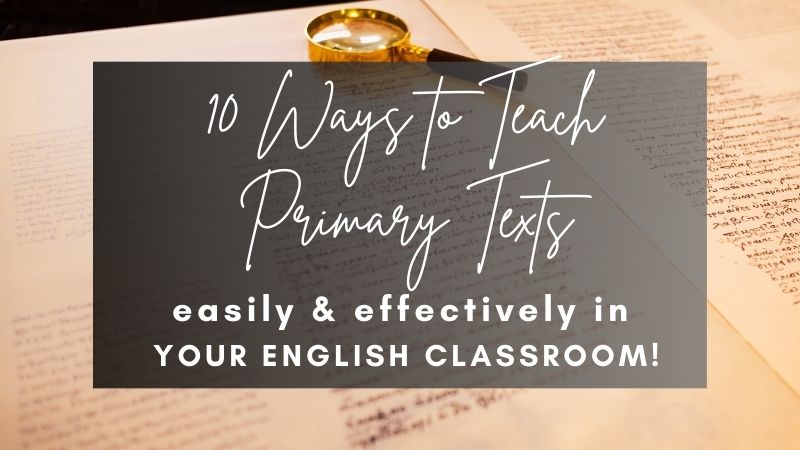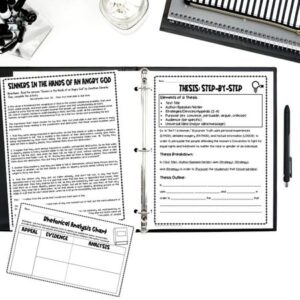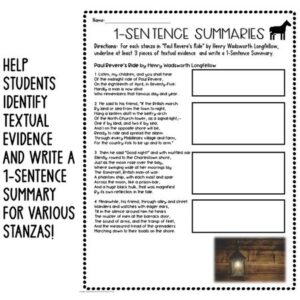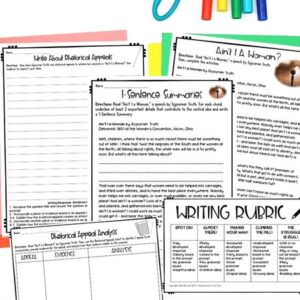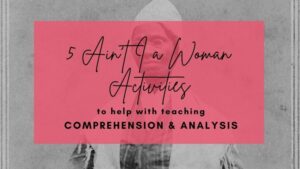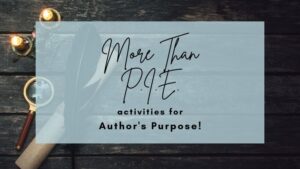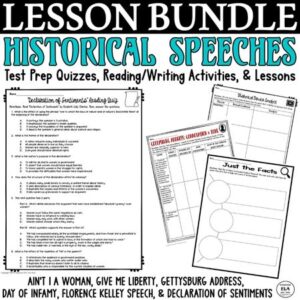As English teachers, we try to breathe life into the texts we teach to increase engagement and understanding as well as encourage a deeper connection (and deeper consideration). We do this often with the literature we teach, but do we do the same with primary texts?
We all know there is no one way to breathe life into a text whether it’s fiction or nonfiction, a primary text or secondary one. The key to breathing life into any text is often through trial and error.
This post includes 10 tried-and-true ways to teach primary texts effectively in your high school English classroom, something we all need a bit of help with once in a while!
Keep reading for 10 Ways to Teach Primary Texts Easily and Effectively!
Need help with Test Prep? Check out this FREE Pack of 3 Test Prep Activities to help students achieve success on standardized tests!

Primary Texts Vs. Secondary Texts
Primary texts are first-hand accounts or original artifacts that provide direct evidence or information usually of a particular event or time period.
Examples of primary texts include historical documents, autobiographies, letters, diaries, speeches, interviews, original research studies, literary works, and artifacts from a specific time period.
A secondary text interprets or analyzes that first-hand account or original artifact.
Examples of secondary texts include history textbooks, scholarly articles, biographies, critical essays, documentaries, and literary analyses.
Incorporating BOTH types of texts into your curriculum is not only important but necessary for students to be successful!
10 Ideas for Teaching Primary Texts
1. Integrate with other time period resources
Teaching texts chronologically like many do in American Lit or Brit Lit courses, means you can easily integrate primary texts. Think about the time period of a fictional text you plan to use and search for options of either well-known or lesser-known but still strong texts. Speeches are always a good option that can also facilitate teaching the author’s purpose or rhetoric.
For example, if you’re teaching primary texts from the Puritan or Colonial periods, use Jonathan Edward’s sermon “Sinners in the Hands of An Angry God” from the same period to focus on its content, language, and use of rhetoric.
In order to truly understand this period in history, students must encounter primary texts that provide background information, offer truths about the human condition of the time, and reflect philosophical and religious beliefs!
This lesson, quiz, and activity bundle for this pivotal sermon includes reading comprehension activities, fun graphic organizers, and writing prompts to encourage students to analyze the rhetorical appeals. It also contains detailed lessons that teach students how to write a rhetorical analysis essay step-by-step from the reading of the text all the way to the final essay.
2. Teach during relevant times of the year
A quick way to engage students is to tie it to their lives whether that’s through a major topic, current relevance, or even timeliness. Think about what primary texts might work in certain months of the year. This process might coincide with holidays or historical dates.
For example, teaching FDR’s Day of Infamy speech in response to the attack on Pearl Harbor around the date it was originally delivered – December 7, 1941 – can make it more meaningful for students.
Use this ready-made resource with reading and writing activities to help students analyze the Day of Infamy speech as well as Roosevelt’s speech the day after. The resource includes worksheets, lessons, and a test prep quiz with 15 reading comprehension questions and answers for middle and high school students, which focus on the Common Core standards and are modeled after various state exams!
You can utilize this process for pretty much ANY primary text!
3. Make thematic connections between fictional and primary texts
Using primary texts in a unit you’re already doing is an ideal way to integrate them. You can connect primary and secondary texts through the themes of different units or texts. While it would be great to match time periods for primary and secondary texts – or the setting for the secondary text – it is not a requirement.
Have a unit about courage featuring fiction or nonfiction texts? Maybe it’s a unit about rhetoric or even a poetry-specific unit? If so, adding in Patrick Henry’s “Give Me Liberty” speech or Longfellow’s “Paul Revere’s Ride” poem are great choices!
This easy-to-use set of activities for Patrick Henry’s speech to the Virginia Convention will have your students digging into this iconic and historically relevant speech.
And these activities about Longfellow’s famous historical poem “Paul Revere’s Ride” will make teaching poetry a cinch! Summarize, analyze, and extend students’ understanding of the poem with easy-to-follow teacher instructions and answer keys.
4. Listen to audio recordings
It’s always a great option to look for primary texts that also feature audio or video components. But when this is not possible, the next best option can be reenactments. When looking for reenactments make sure it’s a quality source. Sites such as C-Span, PBS, and History.com are all reliable options and have a variety of recordings to explore.
If you’re teaching Sojourner Truth’s “Ain’t I A Woman?” speech, check out these audio reenactments:
- The first version is by renowned African-American actress Kerry Washington.
- The next set is part of The Sojourner Truth Project featuring different Afro-Dutch women delivering the speech to best mimic Truth’s authentic voice.
Once students have listened to the speech, ensure their understanding and engagement by using this lesson bundle with reading comprehension test prep questions and answers, rhetorical analysis worksheets, 1-sentence summary organizers, and writing activities!
Check out 5 activities for Sojourner Truth’s “Ain’t I a Woman?” speech below!
5. Contextualize with historical documentaries and film clips
When an audio component – real or recreated – is unavailable, move to film clips. Again these can be historical documentaries such as the myriad of options available on History.com in their section for speeches.
Also, consider film clips – even those created by Hollywood – since there have been biopics and historical dramas that incorporate famous speeches. For example, Selma released in 2014 incorporates Martin Luther King Jr.’s “Our God is Marching on” speech from 1965.
There are so many options available now with streaming platforms!
6. Preview vocabulary
Historical primary sources can be quite difficult to read so a key approach is to preview the vocabulary students will encounter. This vocabulary list can include specific words of a period or the primary text document itself. It is also important to provide context for primary documents in terms of vocabulary and word choice that might have fit the moment but no longer befits our contemporary society.

Examining the Declaration of Independence in an Early America Unit or Revolutionary War Unit is a go-to text, especially in 11th-grade English and History. In fact, it can be used in a wide variety of units and lessons. I would argue it should be taught pretty much EVERY year in high school, as it is one of the most important documents in connection to the foundation of our American government!
Make life easier with this bundle of activities that includes test-prep questions aligned to CCSS, a rhetorical analysis writing pack, citing evidence activities, and 1-sentence summary organizers!
7. Read with your students
It’s a good idea to spend time with your students actually going through primary sources because they can be tough to understand. You can chunk a text if it’s particularly long or power through a shorter primary text when possible.
A great primary text choice is to explore Elizabeth Cady Stanton’s “Declaration of Sentiments” speech. While a higher level text, if you read it with your students, their comprehension will increase dramatically as you can stop and analyze, think aloud, or ask questions along the way. It is not long, but it should be required high school reading because of its relevance even today!
Spend a week with background context and the activities in this bundle to focus on comprehension, summarizing, rhetorical analysis, and more!
8. Annotate as you read
While you’re reading the text in full or in chunked sections, model your process from beginning to end so students can see the steps involved in making sense of a primary text.
Annotating could include ways to make notes in the margins, when possible. Think highlighting or underlining, circling unfamiliar words or terminology (and defining these!), or adding a question mark to a spot where you will need to return and dive deeper to understand it.
An important aspect of the annotation process for a primary text is to show students that a single reading is never enough to comprehend the intricacies of a text, especially a primary source of a different time!
Feel free to read through and annotate for a different purpose EVERY time!
9. Teach Author’s Purpose
Beyond providing students with a purpose for reading a particular primary text, have them examine the author’s purpose in writing and sharing the text. Since a speech will always have a different purpose than an oral myth, a diary, or a letter will have, it’s important to identify and examine the author’s purpose.
First, spend time teaching or reviewing the concept. Then, define different purposes an author might employ. This process can be done as a brainstorming activity with students in small groups or as a think-pair-share within a full class.
Using that knowledge, students can examine yet another aspect of a primary text. They can also evaluate the effectiveness or lack thereof of the author’s purpose through a close reading facilitated by earlier reading and annotation.
For more on exploring the author’s purpose, check out this blog post to make teaching this standard simple and easy!
10. Examine rhetorical strategies and approaches
Dive even more deeply into a text by evaluating its effectiveness through the author’s use of rhetorical strategies and approaches. This strategy can be quite appropriate for speeches and specific letters.
Plus, it is an opportunity for close reading that extends the annotation process as well as the examination of the author’s purpose.
Here are some guiding questions for this rhetorical analysis task:
- How do you know what the author’s purpose is for this text?
- Who is the author’s intended and unintended audience?
- What language or strategies are used to clarify this purpose?
- What is the tone of the text? How do you know?
- What does the author or speaker hope to achieve immediately as well as in the future?
Each question, asked separately or in conjunction with one another, will push students to a second or even a third reading of primary texts to ensure a close reading.
Add in more close reading and accountability with this bundle of historical speeches primary texts featuring “Ain’t I a Woman,” “Give Me Liberty,” the “Gettysburg Address,” “Declaration of Sentiments,” and “Day of Infamy”! Be ready to go with copies of all of these speeches along with activities for summarizing, analyzing, and writing! Plus, you will get a bonus poetry lesson with “Charge of the Light Brigade” by Alfred, Lord Tennyson.
A FINAL WORD ON TEACHING PRIMARY TEXTS
At the end of the day, when tackling any challenging text, it’s important to have a stockpile of approaches you can use to support your students. This is so true with primary texts that were written in periods of history that are unfamiliar to students and/or contain references and vocabulary that are new or unknown to them too.
Consider this list of teaching strategies and relevant resources as your ready-to-use stockpile to breathe life into any and all primary texts for your English classes!
Primary Texts Resource:
This Historical Speeches BUNDLE contains 80 reading comprehension QUESTIONS and ANSWERS for the texts “Ain’t I a Woman,” “Give Me Liberty,” the “Gettysburg Address,” “Declaration of Sentiments,” and “Day of Infamy” as well as ENGAGING and RIGOROUS reading and writing activities to make teaching these iconic speeches SIMPLE & EASY!
My goal is for test prep to become a natural and easy part of the curriculum, instead of something else you have to create. Give yourself a breath of fresh air with this NO PREP curriculum that integrates test prep within the teaching of literature!
Just PRINT & TEACH!!
Crave more fun ideas for teaching primary texts? Check out my store Kristin Menke-Integrated ELA Test Prep!

